BANZAI CHARGE FAILS TO EVICT GIs FROM SAIPAN
Saipan, Marianas, Central Pacific • July 6, 1944
The Battle of the Philippine Sea (June 19–20, 1944) was a pivotal U.S. naval victory, effectively eliminating Japan’s ability to both conduct large-scale carrier actions and reinforce its garrisons to the east in the Mariana Islands chain. The most important islands in the Marianas were Guam (an American territory captured by Japan on December 8, 1941), Tinian, and Saipan (two Japanese World War I mandates). In the 1940s Saipan’s civilian inhabitants were predominantly Japanese, not Chamorro as the indigenous peoples of the Mariana Islands are called.
Amphibious U.S. Marine and Army divisions had landed on Saipan beginning June 15. On this July 6, 1944, night, 3,000 Japanese defenders on Saipan—realizing that they could not defeat the invaders—hurled themselves against American lines in the largest banzai charge of the war. Led by Japanese officers swinging swords overhead, the suicidal charge of able-bodied men in the front ranks, the lame and wounded in the rear, some armed only with rocks or knives mounted on sticks, left most Japanese attackers dead and battle-hardened Marines and soldiers shaken to the core.
The self-inflicted slaughter was not over. The next day brought another suicidal banzai charge and mass suicides, including that of Emperor Hirohito’s hero at Pearl Harbor and Midway, Vice Admiral Chūichi Nagumo. Two U.S. Army regiments were almost destroyed, losing 650 killed and wounded in this last-ditch charge on July 7. Hundreds of Japanese civilians, brainwashed by Japanese propaganda that they would be killed if captured or imbued with the national philosophy that suicide as “a shield for the Emperor” was an honorable death, jumped off cliffs, drowned themselves in the sea, were blasted out of caves with their uniformed defenders, or blew themselves up with grenades. All told, 29,000 Japanese military and 22,000 civilians (over half the local population of the island) died versus 3,426 American dead and 10,364 wounded, making Saipan the most costly victory to date in the Pacific War.
News that Saipan had been lost caused Japanese Premier Hideki Tōjō and his cabinet to resign later in the month. Until Saipan’s capture the Japanese populace continued to believe that success in the war remained possible. Now Japan’s leadership was forced to begin considering the reality of defeat. Marine General Holland M. “Howlin’ Mad” Smith, ground commander of the assault on Saipan, declared that the U.S. victory “opened the way to the home islands” by providing secure air bases for the new long-range heavy bombers that were now within striking distance of all Japanese cities. Four months later one hundred B‑29 Superfortresses departed Saipan’s new U.S. airstrips for their first massive air raid over Tokyo.
![]()
![]()
Saipan and Tinian, 1944–1945. U.S. Begins End Game for Pacific War
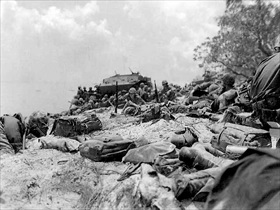 | 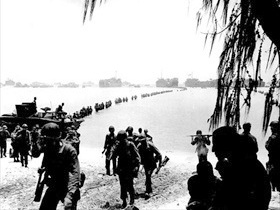 |
Left: U.S. Marines take cover on Red Beach, June 15, 1944. The invasion fleet of hundreds of ships carried more than 70,000 Marines and soldiers. Shelling the 72-square-mile, pistol-shaped island began on June 11, 1944, and lasted for more than three days. Landings began on the west side on June 15 when the 2nd Marine Division hit Red and Green beaches and the 4th Marine Division hit Blue and Yellow beaches.
![]()
Right: Soldiers of the U.S. Army 27th Infantry Division, green reinforcements, disembark from LSTs and proceed across a coral reef on the extreme southwest coast of the Saipan. Photo from June 16 or 17, 1944.
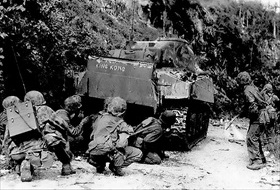 | 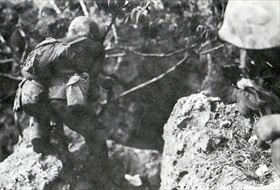 |
Left: Marines take cover behind an M4 Sherman tank while clearing out the northern end of Saipan island, July 8, 1944.
![]()
Right: Holding a Colt 45 pistol, a Marine moves cautiously through the Saipan jungle, July 1944, as he and his platoon ferret out the enemy. Out of a 30,000-strong garrison, less than 1,000 Japanese were taken prisoner. The suicides and banzai charges were called gyokusai, which can be roughly translated as “breaking the jewel,” a reference to the destruction of an entire Japanese unit. Gyokusai can only be made at the behest of Imperial General Headquarters, the Japanese equivalent of the U.S. Joint Chiefs of Staff.
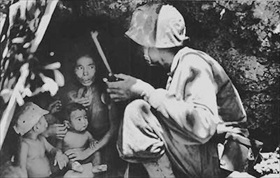 | 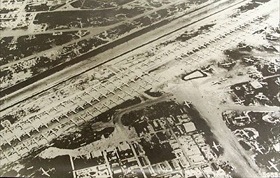 |
Left: Marine Lt. Robert B. Sheeks, an Intelligence and Japanese Language Officer, coaxes a terrified island native (a Chamorro woman) and her children into abandoning their hiding place, circa June 21, 1944. Using a combination of surrender leaflets and amplified voice appeals, Sheeks personally ended up saving the lives of hundreds of Japanese civilians and servicemen by being able to talk them out of the many caves in Saipan’s and neighboring Tinian’s volcanic landscape during combat in 1944. On Saipan, Sheeks was awarded the Bronze Star for his “heroic achievement.” Another Japanese-language speaker, Marine Pvt. Guy Gabaldon, was responsible for single-handedly negotiating the surrender of 800 Japanese soldiers and civilians on Saipan and turning them over to U.S. military authorities. For his exploits, Gabaldon became known as the “Pied Piper of Saipan.” On Tinian he continued his remarkable career, capturing another 700 Japanese. The Navy awarded Gabaldon the Silver Star medal, which it upgraded in 1960 to the Navy Cross, the second highest U.S. military decoration.
![]()
Right: Isley Field on Saipan is filled with hundreds of four-engine B‑29 Superfortresses in this mid-1945 photo. The Marianas were desired by the U.S. as bomber bases to reach the Japanese mainland, with Saipan attacked for that reason even before the U.S. moved to recapture Guam. Once captured, Saipan and Tinian were used by the U.S. Twentieth Air Force because the islands finally put mainland Japan within round-trip range of B‑29s. In response, Japanese aircraft attacked the bases on Saipan and Tinian from November 1944 to January 1945. Both the Enola Gay and the Bockscar (which dropped atomic bombs on Hiroshima and Nagasaki, respectively) flew their missions from Tinian’s “North Field,” whose four runways comprised the largest single airport in the world at the time.
The Invasion of Saipan, June 1944: Piercing Japan’s Pacific Defensive Perimeter
![]()

 History buffs, there is good news! The Daily Chronicles of World War II is now available as an ebook for $4.99 on Amazon.com. Containing a year’s worth of dated entries from this website, the ebook brings the story of this tumultuous era to life in a compelling, authoritative, and succinct manner. Featuring inventive navigation aids, the ebook enables readers to instantly move forward or backward by month and date to different dated entries. Simple and elegant! Click
History buffs, there is good news! The Daily Chronicles of World War II is now available as an ebook for $4.99 on Amazon.com. Containing a year’s worth of dated entries from this website, the ebook brings the story of this tumultuous era to life in a compelling, authoritative, and succinct manner. Featuring inventive navigation aids, the ebook enables readers to instantly move forward or backward by month and date to different dated entries. Simple and elegant! Click 











